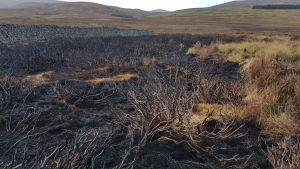Another 3,000 hectares of Scotland’s peatlands will begin the road to recovery this winter, Environment Minister Aileen McLeod has announced.
The country’s blanket bogs are one of the world’s rarest habitats and a unique habitat for wildlife. Intact peatlands can also help to mitigate climate change by locking in carbon from the atmosphere.
More than 5,500 hectares are already in the process of being restored through Scottish Natural Heritage’s (SNH) Peatland ACTION project. Now, an additional £3 million Scottish Government funding announced in June is enabling the restoration of another 3,000 hectares.
Speaking from the UN climate talks in Paris on World Soils Day, Dr McLeod said:
“Almost a fifth of Scotland’s land is covered with peat, the soil that supports our internationally important blanket bogs. As well as being a key habitat for much of our wildlife, they play an important role in carbon capture and storage, helping reduce our greenhouse gas emissions.
“The importance of restoring peat-forming habitats which have been drained or damaged cannot be underestimated. That is why the Scottish Government is providing an additional £3 million funding as part of the additional climate change measures I announced in June.
“This money will go towards expanding the vital work to preserve and safeguard Scotland's peatlands as part of the SNH-led Peatland ACTION project, which is developing innovative, simple and cost effective restoration methods to maximise the area being restored.”
Eileen Stuart, SNH Head of Policy and Advice, said:
“This additional funding, plus the £5 million already invested by the Scottish Government since 2013, will give a massive boost to the health of Scotland’s peatlands. This work is crucial to protect this important habitat which is home to many important animals and plants, as well as playing a vital role in reducing carbon emissions and help to regulate water flow.
“We had our first meeting of the National Peatlands Group this week and it is clear there is real enthusiasm to build on the work of Peatland ACTION and our partners and to lead the way on restoring Scotland’s peatlands.”
About Peatland ACTION
The Peatland ACTION Project is a Scottish Natural Heritage initiative to reduce carbon release into the atmosphere. It will contribute to the objectives of Scotland's National Peatland plan which was published in August following public consultation last year, and which sets out a vision to protect, manage and, where required, restore our peatland. This ensures peatlands are in a resilient condition to cope with the anticipated impacts of climate change as well as to reduce the amount of carbon in the atmosphere. To help deliver this important agenda Scottish Natural Heritage is leading a National Peatland Group which met for the first time this week. This Group is made up of a wide range of Scottish Government agencies, conservation organisations, land managers and industries with an interest in peat.
In addition, Peatland ACTION will contribute to the delivery of Scotland’s Biodiversity Route Map Priority Project 1, the restoration of peatlands.
Peatland ACTION has been trialling innovative methods of restoration. Some have an almost instantaneous result where the bare peat is reprofiled and turfed using the surrounding vegetation to stabilise the bare eroding peat. Other methods take many years to repair the damage caused by drainage. Peat is the soil that supports much of our internationally important blanket bog vegetation.
Peatland ACTION supported projects run by the Cairngorms National Park which won the ‘innovation’ class at the Nature of Scotland awards earlier this month for work creating a ‘living carpet’. The living carpet is a mix of bog moss and heather cuttings spread across the eroding bare peat. The living carpet protects the surface from the ravages of the weather and encourages plants to recolonize the more stable surface.
By using simple cost effective techniques that can be widely adopted by land managers, much larger areas can be completed. The Peatland ACTION Project is keen to promote these innovative methods through demonstration events and can be viewed in videos and guidance on the Peatland ACTION webpage:www.snh.gov.uk/peatlandaction
Less than two per cent of Scotland's bogs are raised bogs and occur mostly in the central belt and on the Grampian Plain. The rest are blanket bogs, found over much of the north-west Highlands, the islands and in most of our upland areas. Although rare, Scotland has around 40 per cent of Great Britain's total extent of raised bog and around 50 per cent of the near-natural raised bog. Around 60 raised bogs in Scotland are designated as Sites of Special Scientific Interest (SSSIs).










